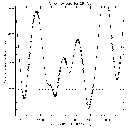Observation of expanding active-region loops
Science nugget: Feb 14, 1998
The internet provides an interconnectivity between the
world's solar observatories that allows us to tell each other what we're
doing from day to day. In many cases this allows us to collaborate, as
is the case with this week's Science Nugget. The SOHO Operations plan on
the web showed that CDS was planning to make observations of the active
region AR 8151; we were able to adjust the SXT commands to follow the CDS
plan, so that SXT also observed AR 8151 on 12-Feb and 13-Feb.
CDS investigator P. Maltby expressed that they were interested
in detecting "the CDS counterpart to expansion flow detected by Uchida
et al. (1992, Publ. Astron. Soc. Japan, vol. 44, L155)."
In that paper, Uchida et al. described the expansion of coronal
loops in the outer portions of active regions.
As SXT and CDS were watching AR 8151, SXT observed expansion in
the northwest portion of the target region, a movie of which can be seen
here.
Very preliminary calculations suggest the leading edge of the X-ray
brightening travels to the northwest at a speed of only 10-30 km/sec. With
luck, Doppler measurements from CDS will tell us whether we're actually
seeing plasma motion, or the appearance of plasma motion (i.e.,
a succession of loops brightening in turn).
Special notes: Preparation for the Eclipse of Feb. 26
A well-situated solar eclipse is coming up on Feb. 26, and we are engaged
in planning observations from Yohkoh. The rapid motion of Yohkoh
makes it whiz in and out of eclipse several times, as shown in the plots
below. Please refer to the planning page for
further details, and we will present a view of the real thing in our notes
for Week 9.
David McKenzie and Hugh Hudson, 14-Feb-97 UT (email mckenzie@isass0.solar.isas.ac.jp,
hudson@isass0.solar.isas.ac.jp)



